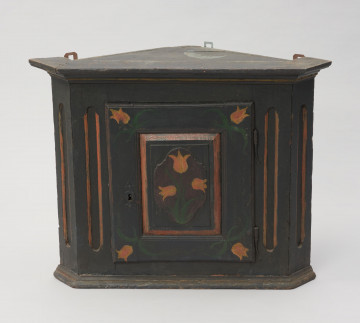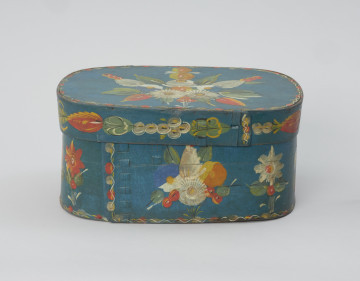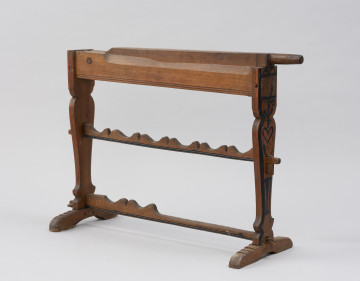
Corner cabinet hanging
połowa XIX wieku
National Museum in Szczecin
Part of the collection: Pyrzycka folk culture
Nowadays, a handbag is an indispensable element of a woman's outfit with countless cuts and colours, formerly associated with emancipation that brought women into the mainstream of professional life. In the past, a handbag, often made of the same material as the dress, held only a few small items: a bottle of perfume or sober salts, an embroidered handkerchief, a mirror, or perhaps glasses. Rural women did not carry handbags, and what is characteristic and puzzling, in most cases, their clothes did not even have pockets. There was no room for trinkets in the daily activities of rural women. Those women who handled money hid it in a leather or textile bellow or wrapped it in a knot made of a piece of cloth. The Pyrzyce women, as in the case of other items of clothing such garters, gloves, muffs, also managed to make an elegant and eye-catching item out of a bellows/bag. The bag was fixed to the selvedge and tied together at the waist, and its colour was coordinated with the colours of the apron and shawl. The handbag from the collection of the National Museum in Szczecin was made of velvet, leather, silk and decorated with gold thread. Both sides are decorated with floral embroidery, characteristic of the Pyrzyce region. Folk ornamentation usually contains symbolic information. In this case, forget-me-not flowers symbolise fidelity, rose-like flowers symbolise fertility, and oak leaves - strength and longevity. There are two A.G. and G.M. monograms embroidered on the bag as well.
Iwona Karwowska
Author / creator
Dimensions
cały obiekt: height: 29 cm, width: 20 cm
Object type
folk costume
Creation time / dating
Creation / finding place
Identification number
Location / status

połowa XIX wieku
National Museum in Szczecin

połowa XIX wieku
National Museum in Szczecin

1801 — 1900
National Museum in Szczecin
DISCOVER this TOPIC
National Museum in Szczecin
DISCOVER this PATH
Educational path